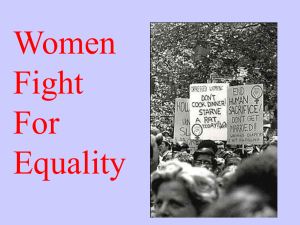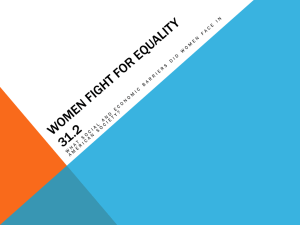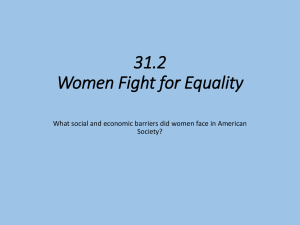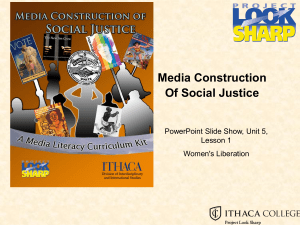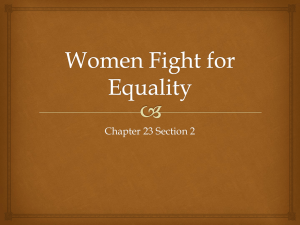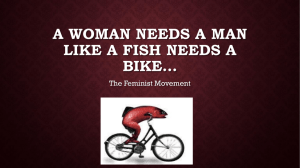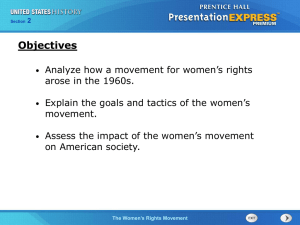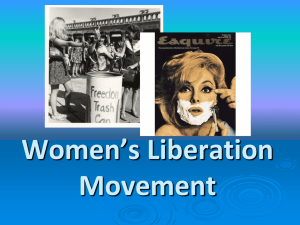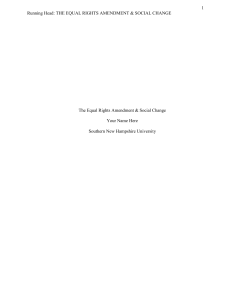List some ways in which woman have yet to be recognized as equal
advertisement
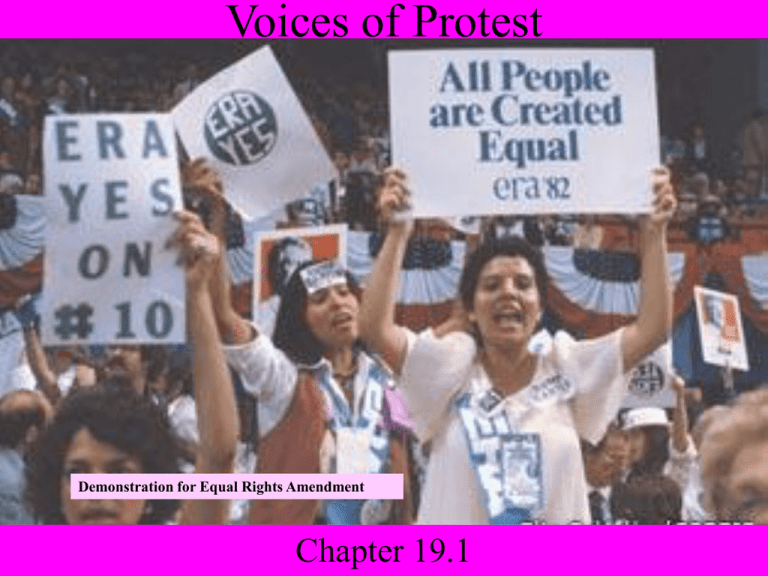
Voices of Protest Demonstration for Equal Rights Amendment Chapter 19.1 A Woman’s Place Traditional wedding couple: she could look forward to fifty years of baking cookies What are the origins of the Women’s Movement? • Outgrowth of civil rights movement: women built on it – Saw themselves as treated like second class citizens – Expected to make Above: traditional family supper; below: Betty Friedan poses sandwiches, type, stay at home • Betty Friedan – “The Feminine Mystique” – “Is this It?” How did reproductive rights change in the 60s and 70s? • The Pill – FDA approved sale in 1960 – Women became more health conscious – Some felt greater freedom • Pregnant women were usually fired from their jobs • Roe v. Wade (1973) legalized 1st trimester abortion Above: The Pill (month’s supply); below: anti-abortion protests Describe NOW and its goals: • NOW- National Organization of Women • Goals was full equality for women – Constitutional amendment (ERA) – Maternity leave – Better day care centers – Equal/ non-segregated education – Equal job opportunities – Abortion rights • 270 thousand members by 1990 Above: NOW logo; below: NOW parade Describe the radical feminists: • Younger, smaller groups and more ‘dramatic’ than NOW • Ridiculed the 1968 Miss America pageant by crowning sheep • Threw girdles, bras, curlers, and other symbols of “feminine enslavement” into the freedom trashcan Above: 1960s Miss America; below: feminist protestors Radical Feminists Capture from clip on radical feminists Gloria Steinem Presentation A young woman (not Gloria) serves drinks in a Playboy bunny suit Describe the successes of the Women’s Liberation movement in the 1970s: • Gloria Steinem & Ms. Magazine – Wrote about issues Cosmo and Good Housekeeping avoided – Popularized “Ms.” instead of Miss or Mrs. • Women’s Studies appeared in universities (you could major in it) • By 1980: – 51% of undergrads were female – 30% of doctorate degrees female Above: A Playboy bunny serves drinks Phyllis Schlafly Presentation Schlafly gives an anti-feminist speech Who was Phyllis Schlafly? • Conservative Anti-feminist • Lawyer and author • The Power of the Positive Woman (1977) – Stated that women primary duty uphold traditional values • Church, family, country • Argued that feminists did not represent all women • Led STOP ERA movement – Said it would lead to unisex bathrooms, women in combat, and the destruction of the traditional family Above and below: Phyllis Schlafly How did Congress and the Courts react to the Feminist Movement? • Affirmative Action Plan (1971) – Forced Businesses working with US Gov to have a certain percentage of females • Education Amendments Act (1972) – Outlawed sexual discrimination in education • Forced schools to change classes – cooking no longer limited to girls, shop to boys • US military opened up academies of Annapolis and West Point to female cadets Above: home economics in the 1950s Below: Describe the ERA and the fight for its ratification: Photo of an ERA rally in this century (web address on banner, reference to 9-11 on sign) Describe the ERA and the fight for its ratification: • “Equality of rights under the law shall not be denied or abridged by the United States or by any state on account of sex.” • Amendment overwhelmingly approved by Congress • In order for the Amendment to be added to the Constitution, 38 States needed to ratify it (3/4 of states). • 30 did by 1973 • Conservatives fought vigorously against the Amendment – Fear that it would change social and family roles • By the 1982 deadline, NOW’s fight for the amendment died, and Congress did not extend the deadline. How did the Feminist movement affect social and gender relationships? • Marriage postponed – Women entered college to prepare for careers • Divorce rate climbed – More socially acceptable to leave unsatisfying marriage • Socially acceptable behavior uncertain – What was considered gentlemanly behavior changed • Should a man hold the door for a lady or is that being a chauvinist? Below: cartoon makes the serious point that chivalry made more sense when tasks were dangerous and physically demanding What were the results of the Feminist Movement? • More women in the workplace • Ms. Became title in business – Took marital status out of workplace • Two-career family became norm • Women continued to rise in status – Sandra Day O'Connor (1st female justice in Supreme Court in 1981) – Geraldine Ferraro (Democratic VP candidate in 1984) – Sally Ride (1st female in space in 1983) – Hillary Rodham Clinton!!! Below: Gloria Steinem on 30th anniversary cover of the magazine she founded
